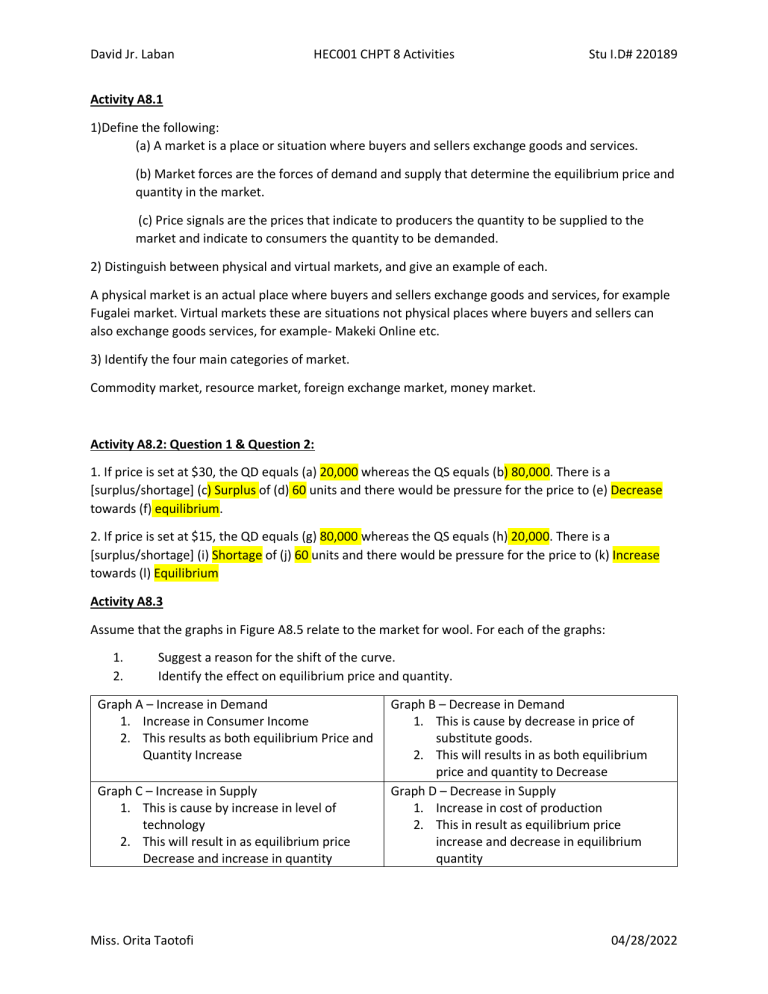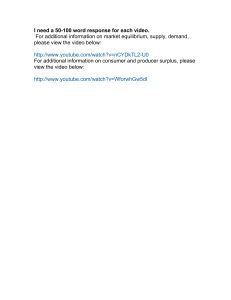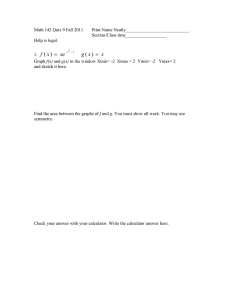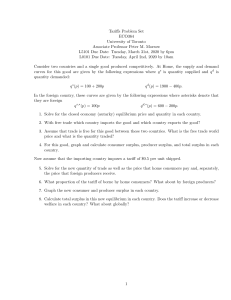
David Jr. Laban HEC001 CHPT 8 Activities Stu I.D# 220189 Activity A8.1 1)Define the following: (a) A market is a place or situation where buyers and sellers exchange goods and services. (b) Market forces are the forces of demand and supply that determine the equilibrium price and quantity in the market. (c) Price signals are the prices that indicate to producers the quantity to be supplied to the market and indicate to consumers the quantity to be demanded. 2) Distinguish between physical and virtual markets, and give an example of each. A physical market is an actual place where buyers and sellers exchange goods and services, for example Fugalei market. Virtual markets these are situations not physical places where buyers and sellers can also exchange goods services, for example- Makeki Online etc. 3) Identify the four main categories of market. Commodity market, resource market, foreign exchange market, money market. Activity A8.2: Question 1 & Question 2: 1. If price is set at $30, the QD equals (a) 20,000 whereas the QS equals (b) 80,000. There is a [surplus/shortage] (c) Surplus of (d) 60 units and there would be pressure for the price to (e) Decrease towards (f) equilibrium. 2. If price is set at $15, the QD equals (g) 80,000 whereas the QS equals (h) 20,000. There is a [surplus/shortage] (i) Shortage of (j) 60 units and there would be pressure for the price to (k) Increase towards (l) Equilibrium Activity A8.3 Assume that the graphs in Figure A8.5 relate to the market for wool. For each of the graphs: 1. 2. Suggest a reason for the shift of the curve. Identify the effect on equilibrium price and quantity. Graph A – Increase in Demand 1. Increase in Consumer Income 2. This results as both equilibrium Price and Quantity Increase Graph C – Increase in Supply 1. This is cause by increase in level of technology 2. This will result in as equilibrium price Decrease and increase in quantity Miss. Orita Taotofi Graph B – Decrease in Demand 1. This is cause by decrease in price of substitute goods. 2. This will results in as both equilibrium price and quantity to Decrease Graph D – Decrease in Supply 1. Increase in cost of production 2. This in result as equilibrium price increase and decrease in equilibrium quantity 04/28/2022 David Jr. Laban HEC001 CHPT 8 Activities Stu I.D# 220189 Activity A8.4 1. What is a surplus? - A surplus is where the price is set above equilibrium, resulting in quantity supplied exceeding the quantity demanded. 2. Illustrate and explain how each of the following could result in a surplus: a a change in supply – Increase in Supply As we can see the original price was $20. After the change in market conditions the quantity supplied is now 8000 and the quantity demanded is now 4000 which leads to a Surplus (excess of supply) of 4000 units (=8000-4000). 20 18 4 b 6 8 Output a change in demand – Decrease in Demand The decrease in demand creates a surplus. While buyers are now willing and able to buy fewer Ice Cream, sellers continue supplying the original quantity at the original price. Up to this point, they have no reason to change. Market Forces will automatically drive the market back toward the equilibrium. P1 SURPLUS Miss. Orita Taotofi 04/28/2022 David Jr. Laban HEC001 CHPT 8 Activities Stu I.D# 220189 Activity A8.10 1. Suggest why the government may impose a minimum price on a market. -Because this will protect Sellers from suffering declines in their revenue when market is unreasonably low. 2. Explain why a minimum price control will only have an impact on a market if set above equilibrium price. -Because if the control price was set below equilibrium this would have no impact on the market, whereas if it was set above equilibrium price it would lead to a SURPLUS because price cannot or unable to fall to the Price Equilibrium. 3. Draw a graph to show the effect of a minimum price on a market. Surplus 4. Explain how consumer and producer surplus are affected by minimum price control. - The consumer Surplus is reduced from G,J,H to G, and the new producer surplus is increase from I,K to H,I. In effect, the price floor causes the area H to be transferred from consumer to producer surplus. Miss. Orita Taotofi 04/28/2022 David Jr. Laban HEC001 CHPT 8 Activities Stu I.D# 220189 5. Define deadweight loss (DWL) and describe why a minimum price control leads to a DWL. -The Deadweight loss (DWL) represents a loss of consumer and producer surplus that is not gained by anyone else, but is lost from the market, and it is because the market is no longer able to reach the equilibrium. Activity A8.11 1. Define a ‘quota’. - A quota is a quantitative limit or restriction imposed by government on the quantity allowed to be traded in a market. 2. Discuss reasons why a government may wish to impose a quota on a market. - The government could impose a quota on imported commodities to restrict the flow of imports to reduce the country’s current account deficit or imposing quotas to restrict the exploitation of a resource that is becoming depleted, for instance limiting the amount of Taro that may be caught in order to conserve the Taro stocks. Activity A8.12 1. Draw a graph to show how an increase in indirect tax will affect the market for a commodity. On your graph show each of the following: a. original price and quantity b. new price and quantity c. change in CS, PS and DWL. Miss. Orita Taotofi 04/28/2022 David Jr. Laban HEC001 CHPT 8 Activities Stu I.D# 220189 Activity A8.13 1. Draw a graph to illustrate the impact of a subsidy on the market for a commodity. Your graph should show the following: a. original price and quantity b. new price to consumers and producers, and the new quantity c. change in CS, PS and the existence of any DWL. Miss. Orita Taotofi 04/28/2022





